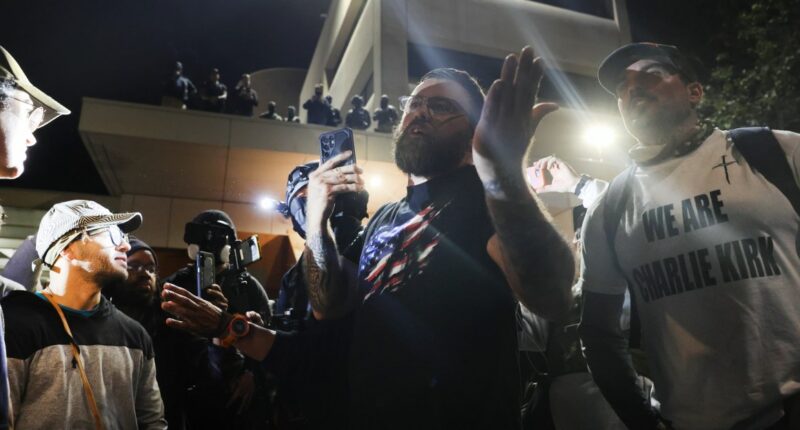Share this @internewscast.com
The ongoing legal battle regarding the president’s authority to deploy troops in Portland, Oregon, hinges on whether the judiciary relies on firsthand observations or digital information.
From its inception, the lawsuit has faced a reality distortion driven by social media influencers, some with direct ties to federal entities. These influencers and content creators have played a crucial role, albeit not always visibly, in the National Guard case. They have not only communicated directly with administration officials but have also influenced national policy on “domestic terrorism” and have even been cited in legal documents.
Mere weeks after President Donald Trump hinted at deploying the National Guard to this mid-sized city, a Portland police sergeant expressed frustration via email. He described three counter-protesters at the ICE facility in Portland as continuous sources of police and medical interventions. According to him, despite multiple warnings to avoid the ICE gatherings, these individuals repeatedly returned, provoking protesters until incidents of assault or pepper spraying occurred. The sergeant noted that they engaged in similar trespassing as the main protesters.
The trio of counter-protesters were, and continue to be, very active on social media platform X, where the ongoing conflict contributed significantly to their online presence. A visiting journalist from The Atlantic observed the almost ritualistic nature of the protests, where both sides frequently recorded each other. “They appear to know one another, akin to rival high school teams,” Isaac Stanley-Becker remarked. “Their social media disputes have materialized in real life.” By late September, it became evident that their online activity was fueling the administration’s unusual and broad campaign against anti-fascism, or Trump’s anti-anti-fascist initiative. On September 28th, Defense Secretary Pete Hegseth issued a directive for the National Guard’s deployment to Portland, prompting immediate legal action from the city and the state.
This raises the question: what role was the National Guard expected to play regarding online content?
From the onset, the lawsuit has been characterized by a conflict over the distinction between digital and actual reality. During the oral arguments in State of Oregon v. Trump, District Court Judge Karin Immergut leaned towards what could be considered tangible reality. She expressed confusion when the Justice Department’s attorney contended that the National Guard’s presence in Portland was warranted due to the “doxing” of ICE officials and conflicts between protesters and counter-protesters. She highlighted that the counter-protesters were not federal employees and questioned the National Guard’s role concerning internet activity.
The Ninth Circuit panel, which issued a decision staying the temporary restraining order by Immergut, seemed more fixated on Online. Its ruling brought back massive chunks of evidence that the lower court had deemed to be beside the point — incidents dating back to June, the “doxing” of ICE agents on the internet, and an incident involving a “journalist” (who is called a “counter protester” in Portland Police Bureau records, and whose activities consist mainly of posting for 11,000 followers on X and 1,900 on TikTok) being attacked by a “black blocker.”
Perhaps more alarmingly, the Ninth Circuit opinion is fixated on a period of time from June to July that coincides with the earliest No Kings protests, a time period that the lower court judge thought too far from Trump’s mobilization order to be worth considering.
The appeals court’s decision was published on October 20th, the Monday after nationwide No Kings protests that the organizers estimate drew 7 million people. Portland itself saw a turnout several times larger than the massive protests in June, with crowds full of people in inflatable costumes.
The whole world got to see Portland looking super goofy right before the Ninth Circuit ruled that it was okay for the president to send in the troops, revising the reality of what might be the biggest political mobilization in American history. And the court’s revisionist universe looked awfully similar to the content being produced by right-wing influencers.
The conflict between Trump and reality is long-standing; however, the Ninth Circuit — historically considered a liberal-leaning appeals court — was an unexpected ally in his assault on common sense. But the appeal of the temporary restraining order in State of Oregon v. Trump had landed in front of a three-judge panel with two Trump-appointed judges — a statistically unlikely stroke of bad luck.
During oral arguments, it was painfully obvious which way the Trump judges were going to rule. One of the judges could not stop talking about the year 1792, the Whiskey Rebellion, and rebellion generally (despite the fact that the Trump administration was not actually relying on the rebellion prong of Section 12406 to deploy the National Guard into Portland). The Dallas ICE shooting — over 2,000 miles away from Portland and well outside the jurisdiction of the Ninth Circuit — was mentioned.
But most tellingly, the conservative judges on the panel were fixated on events in June, rather than the embarrassingly quiet scene in Portland in the weeks leading up to Trump’s declaration of war against an extremely minor metropolis.
This focus on June 2025 was remarkable not just because the Ninth Circuit, in mid-October, was hearing an appeal of an emergency order to stop an emergency deployment of the National Guard to address an emergency, but because that period of supposed anarchy in Portland — about three weeks between June 13th and July 7th when the ICE facility in southwest Portland was “forced to close” — coincided with the first round of nationwide No Kings protests.
The first No Kings protest took place on June 14th, drawing approximately 10,000 people across Portland. Unsurprisingly, with that many people out and about, the ICE facility protest — a separate, ongoing protest in another part of town — swelled with people that day. The building may have been “shut down” at the time, but nevertheless, a fed managed to shoot an ER nurse in the eye.
Even setting aside the increasing violence that ICE was inflicting on the general public across the country, the brutalization of protesters inflamed the situation. As July 4th approached, Indivisible began to plan Independence Day protests around the country. For some reason, it decided not to plan a big one in Portland.
The incidents in the record drop off precipitously after July, with the number of protesters dwindling throughout. “Saw 8 people out front and couldn’t even get one of them to flip me the bird” reads one police report cited by the dissent. (The report is dated the same day that Trump publicly compared Portland to “living in hell.”) The Portland police thought the protests had become pathetically “low energy” to the point where it started looking like the feds were scraping at the bottom of the barrel for reasons to be scared.
“Saw 8 people out front and couldn’t even get one of them to flip me the bird”
And the Ninth Circuit panel’s majority opinion is a litany of barrel-scraping. It describes a woman being arrested because the feds believed she has a gun (no mention of whether a gun is found), protesters unloading “a large quantity of sticks and bats” at a protest (no mention of whether they are ever used), and makes much of ICE agents being “doxed” (no mention of what the National Guard is supposed to do about the doxxings). There is also the mention of a “guillotine” constructed in early September; it is telling that no one — not at the lower court, not in the Ninth Court — has ever asked whether any ICE agents have been guillotined. The whole world knows that the guillotine is a piece of theater, little more than a prop for content creation.
If this is all a bad-faith hunt for pretext, that’s alarming enough — but if the Trump judges are truly taking clashes between protesters and counter-protesters seriously, and using them to justify the deployment, the situation is arguably even worse. The National Guard are putatively being deployed to protect federal employees; the obvious conclusion here is that the counter-protesters and right-wing influencers now comprise a paramilitary arm of the federal government that the Trump regime believes is also entitled to protection by the National Guard.
That they might possibly be cranks with fewer than 2,000 followers on TikTok is of no consequence — they now have a direct line to the Justice Department, to guns, and to boots on the ground.
On October 28th, the rest of the Ninth Circuit agreed to hear the case en banc — a rehearing of the original appeal in front of a larger panel of 11 judges. In the interim, the National Guard has been restrained from deploying into Portland as the case progresses in the lower court.
During a three-day trial, it was revealed that the Guard had been briefly deployed on October 4th, in contravention of the restraining order. (“We’ll talk later about whether that’s contempt,” the judge said in court.)
At trial, a Portland police commander described the feds’ use of force against protesters as “startling”; the reality that he saw on the ground did not seem to justify it. The DOJ begged to differ — but feds on the witness stand couldn’t quite bring themselves to endorse Trump’s apocalyptic vision of Portland. “I do not agree with the statement that Portland is burning down,” said a federal law enforcement official in court. He, presumably, lives in reality. However, his boss, Donald Trump, does not.
A couple of days after the trial wrapped, Judge Immergut granted a preliminary injunction against the National Guard deployment.
From the Truth Social post that spawned the deployment of the Guard to the content factory that produced much of the “violence” described by the Ninth Circuit, the Portland National Guard case is simply Way Too Online. The law should, ideally, be based on real life and govern real life. But Portland has become a recursive loop of posting, a manufacturing hub for national policy as envisioned by clout-chasers.
The area in front of the ICE building is crawling with influencers. There’s Katie Daviscourt, who currently has over 269,000 followers on X — up nearly 70,000 since the Portland National Guard order. There’s Chelly Bouferrache, who goes by “Hunnybadgermom,” who now has over 62,000 followers on X, twice as many as she did in September. Then there’s Rhein Amacher, who has 11,000 followers, up from around 3,000 in August. Amacher has not found the same degree of success as the other two, and therefore has fewer archives of his X profile. He was also passed over by the feds when they granted Daviscourt and Bouferrache special access to the ICE facility in October.
But it was Amacher, he of 1,900 TikTok followers, who ended up becoming justification for the deployment of the National Guard into Portland — albeit without his name attached. In late September, federal law enforcement had complained to the local police department about a clash between Amacher and a protester, sending along a video while calling Amacher a “journalist” in their report. The local police, on the other hand, repeatedly identified him as a “counter-protester” in their reports. The journalistic profession is hardly sacrosanct; however, the semantic difference is still significant: a protester fighting a journalist sounds bad, but a protester fighting a counter-protester sounds like a regrettable inevitability. Yet despite his repeated appearances in the Portland Police Bureau’s reports as a “counter-protester,” the appellation “journalist” made it into the lower court decision that had restrained the National Guard; it then appeared in the Ninth Circuit appeals court decision that had undone the restraining order.
The Ninth Circuit didn’t just casually quote the lower court decision, it pulled an entirely fresh quote out of the record, describing the clash as “a ‘black blocker’ assaulting a journalist with a large sword or stick.” The incident, alleged to have taken place on September 19th, is curiously missing from the influencer’s TikTok, which is largely composed of poorly edited and confusing videos of protesters yelling or being beaten by the feds, much to Amacher’s gleeful amusement. His TikTok profile states, “Donald J. Trump for President 2024 🇺🇲.” Many of his posts identify protesters by name, calling them “antifa” or mocking them for being trans. One post calls a protester a “skirt-wearing fraud”; another zooms in on a group of random people in a parking lot, calling the assembly “a herd of wild they/thems.”
Even a permissive definition of “journalist” would have trouble being applied to Amacher. He is, at best, a content creator, and one at the junior varsity level at that. Although his following exploded after Trump promised to send troops to “War Ravaged” Portland, it’s other influencers — like Daviscourt — who’ve gained the most ground in the days and weeks since.
Daviscourt, who writes for the far-right website The Post Millennial, was allegedly beaten by “antifa” on September 30th, just a couple of days after Hegseth’s memo to mobilize the National Guard.
Daviscourt did a round of press on Fox News with apparent bruising on her face. She was even invited to the White House later for a “roundtable” on “antifa.”
The Portland police had more of a dour take on Daviscourt, identifying her as one of the three counter-protesters “that continue to be a chronic source of police and medical calls” in an internal email. (Bouferrache and Amacher are the other two.)
Sortor went on to publicly attack the Portland Police Bureau for being ‘Antifa-infiltrated’
But the police very soon had much bigger fish to fry, as out-of-state influencers swooped in to get in on the content-rich environs of the Portland ICE facility. On October 2nd, local police arrested Nick Sortor of Washington, DC, on suspicion of disorderly conduct. After Sortor was released the following morning, he told his 1.2 million followers on X that he had spoken to Attorney General Pam Bondi. (Bondi later opened an investigation into the Portland police.) Sortor, who was also invited to Trump’s roundtable on “antifa,” went on to publicly attack the Portland Police Bureau for being “Antifa-infiltrated,” an allegation that the Trump administration appears to be taking seriously — the word of an influencer being, apparently, much weightier than the thin blue line.
“Claims of the bureau’s alleged allegiance to antifa may come as a surprise to Portlanders,” noted The Oregonian dryly, reminding its readership that during 2020 the PPB had “filed 6,000 use of force reports” and “arrested nearly 1,000 left-wing protesters.”
Of course, those who read The Oregonian do not need to be reminded how stupid it is to call the Portland police antifa. Locals like District Court Judge Karin Immergut or Ninth Circuit Judge Susan P. Graber are perfectly aware of how ridiculous that assertion is.
And it is locals like Immergut and Graber who are the most appalled by Trump’s attempt to send the National Guard into Portland. “The President’s determination was simply untethered to the facts,” Immergut wrote when issuing her temporary restraining order. Immergut was appointed to the bench by Trump in 2019, but she’s lived in Portland since at least the 1990s; it is hard to convince a local that they live in a “War Ravaged” apocalypse when they saw no such thing while driving to work.
“Given Portland protesters’ well-known penchant for wearing chicken suits, inflatable frog costumes, or nothing at all when expressing their disagreement with the methods employed by ICE, observers may be tempted to view the majority’s ruling, which accepts the government’s characterization of Portland as a war zone, as merely absurd,” wrote Graber in her dissent from the Ninth Circuit decision to stay Immergut’s TRO. Graber once served on the Oregon Supreme Court; the naked bike ride protesting the National Guard deployment wouldn’t be the only naked bike ride she’s witnessed.
It is locals like Immergut and Graber who are the most appalled by Trump’s attempt to send the National Guard into Portland
But touching grass has been absent from the political system for quite some time. The White House’s elevation of the clout-chasing perpetuated by Daviscourt and Sortor can be best understood as a post hoc justification of the National Guard deployment, as well as being part of its ongoing anti-anti-fascist crusade.
An antifa roundtable in Washington, DC, can be happily free from the encroachments of real life. However, an appeals court decision — even if written by a judge a thousand miles away from Portland — begins to sound a little strange when it joins the Trump administration in its assault on reality.
Aside from the brief illegal deployment of the National Guard back in early October, the Trump administration appears to be respecting judicial rulings on the matter. The Ninth Circuit vacated the original panel’s ruling when it voted to rehear the case; things are looking hopeful for Portland. But the Ninth Circuit is but one front in the war on reality, and it’s one that is subordinate to the whims of the Trump-controlled Supreme Court.
It’s notable that Amacher became a “journalist” in the Ninth Circuit because the feds called him one while sharing a video with the Portland police. Content, it seems, has a transmutative effect, and the real war is happening on the ground — a war that isn’t fought with rocks or fake guillotines or less-lethal munitions or tear gas, but with smartphones pointed at smartphones pointed at smartphones. And as more and more content is manufactured at the ICE building — tirelessly captured by actors highly motivated to catch the eyes of Donald Trump, of Stephen Miller, of Pam Bondi — the legal record in the lawsuits around the regime’s war on antifa will continue to warp and decay. And if a pack of internet weirdos can successfully paint the Portland Police Bureau as antifa domestic terrorists, 7 million Americans in frog costumes are just as vulnerable.








